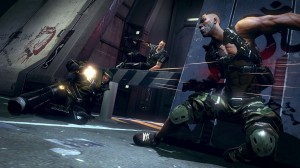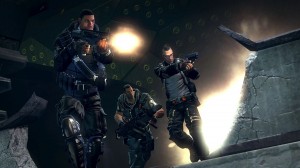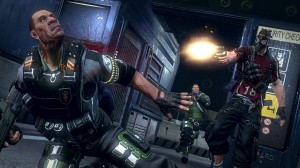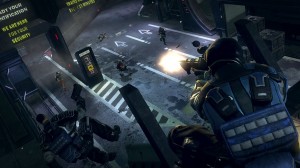Brink Review (PS3)
- Updated: 30th May, 2011
 Brink first grabbed my attention way back in December 2009, when Splash Damage released some very impressive videos, showing off the SMART free-running movement system and objective based gameplay. Brink appeared to have some great unique selling points, that would help it stand out in a sea of generic first person shooters, not least of which was the much vaunted eight player drop-in co-op feature. Now, having finally been released to the world, how does the finished game match up to the initial hype?
Brink first grabbed my attention way back in December 2009, when Splash Damage released some very impressive videos, showing off the SMART free-running movement system and objective based gameplay. Brink appeared to have some great unique selling points, that would help it stand out in a sea of generic first person shooters, not least of which was the much vaunted eight player drop-in co-op feature. Now, having finally been released to the world, how does the finished game match up to the initial hype?
Character Creation
Starting with an introductory video and the character creation screen, Brink makes a very slick first impression. Presentation is clean and clear, with a tidy menu design and some nice ambient sounds dinking about. There are a range of stock characters to choose from, which can all be further modified with hairstyles, tattoos, scars and the like. Whilst they all initially look like extras from a Guy Ritchie film, with suitably ‘geezer’ names to match, you can add a tattoo, some glasses and a face mask, and begin to achieve a pretty unique look. If you are interested in creating a female character to play the game with though, you are seriously out of luck.
Gameplay
 The story in Brink is quite straightforward, with two sides duking it out over control of The Ark – an overpopulated man-made island in a future depleted of natural resources. You play as either the Security forces or the Resistance, and can switch freely between these two sides between games.
The story in Brink is quite straightforward, with two sides duking it out over control of The Ark – an overpopulated man-made island in a future depleted of natural resources. You play as either the Security forces or the Resistance, and can switch freely between these two sides between games.
Played in either campaign or freeplay modes, the script remains largely the same. One side attempts to complete a series of key objectives in order to win the match, and the other side tries to be as much of a hindrance as possible, whilst keeping an eye on the timer ticking away in the corner of the screen. The success or failure of your mission will trigger a cut scene, in which you will see some of the currently involved players feature, in all their HD glory. Ironically this is perhaps the only time you will fully appreciate the finer details of character customisation, as the fast and frantic nature of the battles means you won’t get a close up of anyone’s carefully selected arm tattoos, unless they are heading rapidly for your face, accompanied by a rifle butt.
Brink’s main game modes are all about teamwork, with the completion of secondary objectives helping your team work towards its primary goals. Careful class selection is important, as this will determine what role you will play on the battlefield, at any given time. Pick the right class at the right time, and you can potentially turn the tide of the battle – creating an alternative route for your team, or dashing in to revive your team-mates at a key moment. The use of buffs is also of key importance – these are class specific perks that can be self administered or shared with team-mates.
As you upgrade your character, you will find that a wide range of these buffs are available, beyond the standard set of increased health, enhanced damage, and ammo resupply. Team wide perks can also be administered by taking control of strategically placed command posts.
Splash Damage’s vision for Brink was that all these matches could be played solo, co-operatively or in multiplayer, with human allies or opponents dropping in and out at will, and the player retaining a sense of fluidity throughout the experience. Unfortunately this is where the game begins to fall apart, as the stultifyingly inept AI steps up and fails spectacularly.
Artificial Intelligence
I have been through three stages in my relationship with the Brink AI. At first I was intrigued, and studied it carefully. I was just starting out in the game, and had been helpfully told via a loading screen tip to ‘stick with my team-mates’. It was after about twenty minutes that I realised this might be a bad move. Some of my team-mates seemed to be standing around, just a bus stop away from being recast as criminally insane commuters. Others were trying to take and re-take command centres in a seemingly endless game of cat and mouse with the enemy. Most importantly however, not one of my AI team-mates was actually trying to complete the primary objective.
 This triggered the second stage of my relationship, which can simply be called frustration. A lot of screaming occurred, mostly directed at guys with the names ‘Pieterson’ or ‘Alberto’, who couldn’t hear me, and who would probably just have shrugged and carried on with their self-assigned tasks even if they could. I have heard talk that the Brink AI is deliberately designed to avoid taking the lead on primary objectives, in order to give the player the sense of being the hero. In reality though, this made me feel more like Michael Caine trying to carry out The Italian Job with the cast of One Flew Over the Cuckoo’s Nest.
This triggered the second stage of my relationship, which can simply be called frustration. A lot of screaming occurred, mostly directed at guys with the names ‘Pieterson’ or ‘Alberto’, who couldn’t hear me, and who would probably just have shrugged and carried on with their self-assigned tasks even if they could. I have heard talk that the Brink AI is deliberately designed to avoid taking the lead on primary objectives, in order to give the player the sense of being the hero. In reality though, this made me feel more like Michael Caine trying to carry out The Italian Job with the cast of One Flew Over the Cuckoo’s Nest.
My third, and current, relationship stage, is one of humorous affection. I have grown to love the AI’s kamikaze medic runs, as three of them pile headlong towards me, desperately trying to deliver a revive syringe. They have no regard for their own safety, or the fact that the room I am in is still packed full of enemy troops, which makes me feel terrribly important. I also have a special place in my heart for the operatives that disguise themselves as dead enemy soldiers, and proudly come up to tell me ‘I’m in disguise’. I can even smile at Alberto as he belligerently looks the other way, whilst a lone enemy soldier standing two feet away slowly disarms the door charge I have spent ten minutes trying to arm. Alberto, you may be a fool, but I love you all the same.
Multiplayer Action
In the absence of reliable AI, the saving grace of Brink is the multiplayer aspect. When two or three human players appear on both sides of a match, it can change from a comedy of errors to a fast and frantic series of skirmishes, which actually ebb and flow in the way that Splash Damage must have first envisaged. Far from being a seamless cross over between the single player and multiplayer experiences, it is clear that multiplayer action is what this game is really designed for, and where it works best. Sure, the remaining AI team-mates still conspire to frustrate and amuse in equal measure, but when left to quietly perform back up roles, they have a greater chance of actually being helpful.
 When the game works well like this, it has proven great fun to play. There is an interesting upgrade scheme, which features a wide selection of innovative gadgets to purchase via the customisation screens. Alongside this customisation, the SMART movement system, and the interesting class diversities, there is definitely a lot of potential here for multiplayer gaming.
When the game works well like this, it has proven great fun to play. There is an interesting upgrade scheme, which features a wide selection of innovative gadgets to purchase via the customisation screens. Alongside this customisation, the SMART movement system, and the interesting class diversities, there is definitely a lot of potential here for multiplayer gaming.
Unfortunately, the initial promise of sixteen player campaign matches across all game types has been toned down somewhat post launch, with the number of human players cut to a total of eight in the main game modes, in order to combat lag. In practice, I have generally found fewer than eight human players in the games I have joined. There is a new ‘Big Teams’ option, which allows sixteen human players to join a single game, but in testing on the PS3 I found that this mode resulted in no more human players being included than in other Freeplay or Campaign modes. The highest number of players I encountered was seven, and one ‘Big Team’ game that I joined landed me with just fifteen bots for company, with no trophy ding to acknowledge the inherent irony.
With regard to network issues, I have experienced some low level lag in most of the games I have played, and on a few occasions it has been completely game breaking, to the point where I felt I was being shown a series of flash cards, rather than playing a video game. With Splash Damage promising to work on this known lag issue further, there is still hope that it can be eliminated from the game, or at the very least made bearable for all.
The Future of the Ark
As with all current generation first person shooters, the lifespan of the game is going to depend on the depth of content on offer, and the drip feed of rewards for continuing to play. With a cap at Level 20, the short term rewards for online play are quite limited, as once you hit the cap, you will no longer earn credits with which to purchase new abilities and perks. Likewise, the number of maps available in the game are a concern with regard to long term appeal, particularly as each map is only playable as a single game type, albeit presented in slightly different formats.
 Once you have run through all the available chapters, and replayed them in the eight map freeplay mode, you have seen all the content that Brink currently has to offer. Sure, there are a few challenge missions, but they seem to play more like tutorials than actual game modes, and are over fairly quickly. The in game cuts scenes that accompany each match are fun at first, but they also add to the sense of repetition. After I had seen each one at least once, I found myself frantically stabbing at the skip button every time they popped up.
Once you have run through all the available chapters, and replayed them in the eight map freeplay mode, you have seen all the content that Brink currently has to offer. Sure, there are a few challenge missions, but they seem to play more like tutorials than actual game modes, and are over fairly quickly. The in game cuts scenes that accompany each match are fun at first, but they also add to the sense of repetition. After I had seen each one at least once, I found myself frantically stabbing at the skip button every time they popped up.
Splash Damage had promised that the first round of DLC would be free, and they have now revealed what the ‘Agents of Change’ pack will contain when it is released in June. Crucially, there will be two new maps included, along with an increase in the Level Cap to 24. In addition, there will also be some extra abilities, outfits and weapon attachments on offer. Whilst this is certainly a good start on the road to winning over hearts and minds, it may be a case of too little, too late, for some players.
In Summary
As it stands, Brink is a standard bearer for what might have been. Having promised so much, it has fallen short on delivering those promises. The game has too much potential to dismiss offhand, but is not polished enough to wholeheartedly recommend. Playing Brink solo is an experience best forgotten, thanks to the woeful AI, whilst multiplayer sessions tease the best that the game has to offer, but are hampered by lag and low in-game player numbers. Splash Damage have delivered a very different take on the FPS, which does stand out in a genre that otherwise seems intent on endlessly recycling its best ideas. Sadly, whilst Brink should be free-running into the future, it is more in danger of ending up dead on its feet.
You can buy Brink now on PS3, Xbox 360 and PC


Pingback: Daily News – Free Team Fortress 2, Journey Online Beta and COD … |